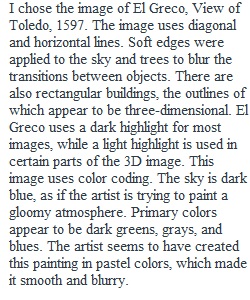


Q Introduction As you begin studying and observing different pieces of art, it is important to practice putting your reactions to the art into words. With this first journal reflection, focus on what you gravitate toward and what thoughts and feeling rise within you as you study this art. Then find descriptive words to write it down within your journal. Unit Learning Outcomes • Define the creative process and describe the roles that artists most often assume when they engage in that process. (CLO 4) • Discuss the different ways in which people value, or do not value, works of art. (CLO 4) • Explain how cultural conventions can inform our interpretations of works of art. (CLO 1, 2, 4) Directions Answer the following questions within your journal reflection: 1. What, in your personal opinion, is the most important thing a good work of art should have or do? Why is that thing important? Please explain as clearly as you can. 2. Include a specific artwork example and explain as clearly as you can how it shows the quality you wrote about in question 1. Include an image or link to the artwork example. As you write your journal reflection, try to be honest, vivid and original in describing your thoughts. Be creative! Use one of the media listed below to create your journal entries (infographic, interactive presentation, or blog.) Click the images below for amazing templates to chose from and start journaling! Due Date • Submit by 11:59 p.m., Sunday, CT. Rubric Unit 1: Journal Reflection Unit 1: Journal Reflection Criteria Ratings Pts This criterion is linked to a Learning OutcomeMost Important Quality of Art The Student describes what they believe to be the most important quality in a work of art and offers an explanation of why they feel it's important. 10 to >8.57 pts Excellent Offers a thorough and clear explanation of their view. 8.57 to >6.43 pts Sufficient Offers a reasonably clear explanation of their view. 6.43 to >0 pts Needs Improvement Offers no or minimal explanation of their view. 10 pts This criterion is linked to a Learning OutcomeExamples The student offers a specific artwork example and describes how it connects to the quality they describe. 10 to >8.5 pts Excellent Offers an example that clearly supports their stated view. 8.5 to >6.5 pts Sufficient Offers an example that mostly supports their stated view. 6.5 to >0.0 pts Needs Improvement Student doesn't connect example with explanation. 0 pts No Marks Offers no example 10 pts This criterion is linked to a Learning OutcomeImage or Link Student gives an image or link to the example mentioned. 5 pts Full Marks 0 pts No Marks 5 pts Total Points: 25 PreviousNext
View Related Questions